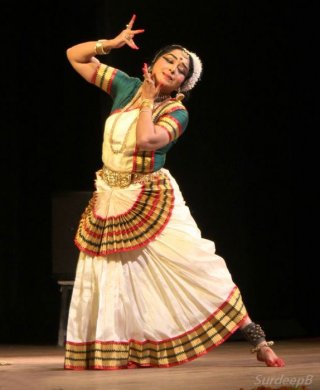
|   |

|   |
Elegant dancing by Gopika Varma - Usha Rk e-mail: simplyushark@gmail.com Photo: B Surdeep October 13, 2014 It was an evening of eclectic, elegant and high class dancing by one of India’s leading Mohiniattam dancers Gopika Varma. As part of the Nitya Nritya annual dance festival, Gopika’s performance enchanted every member of the audience present though it was not heartening to see the sparse turnout. Sometimes I wonder why the young upcoming dancers, the students of dance and even the senior dancers do not find time to attend performances. We were always told that one learns a great deal from watching and internalizing and I believe this is true.  Gopika began the evening with a pushpanjali and a shloka on Vinayaka. From the very go Gopika set the stage with her languid and rounded movements. Her controlled physicality in the execution of nritta spoke volumes of the amount of practice and hard work put in. If her nritta was superlative, her abhinaya left nothing to be desired. It was subtle and restrained. The evening’s fare included three more interesting items. Descriptions of some of the ‘leelas’ or avatars of Maha Vishnu was the larger content of the piece-de-resistance “Paripalaya maam,” a composition of Swati Thirunal in Reetigowla ragam. Gopika delineated the episodes of Gajendra Moksha, Narasimha avatar, varaha avatar and the Mohini avatar as an extension of the lyrics “sharanagata bharanotsaka.” The anguish of Gajendra and his surrender towards his savior, the transition of the expression from an ugra roopa of Narasimha to a shanta or karuna roopa while taking Prahlada into his arms, the aggressive wild boars taking bhumi on his tusks with some interesting movements and the donning of the Mohini roopa by Vishnu to distribute the amruta to the gods and demons in a totally enchanting manner were the highlights of Gopika’s performance of this composition. The ensuing piece was not only engaging but also full of humor. The storyline was a conversation between Krishna and Rukmini who caught him in raptures with the many gopikas. Krishna invites her to a game of dice, ‘I am not a master at this game,’ says Rukmini. Then she comes up with a great idea; she proposes to Krishna that ‘if I win promise me you will never touch any gopi.’ Krishna is shocked… how could he agree to that, how could he live without flirting with the gopis, that was the prime occupation. Krishna retorts by telling Rukmini that he agrees to her proposal on condition that if he wins she will pledge her lips to him for the night. Gopika was in complete control of this amusing folklore ‘Venmani Kritikal’ bringing out her knack to perform light hearted expressions. The concluding item ‘Devaki Pulambal’ penned by Kulashekhara Alwar and translated by Puthuseri Ramachandran, moved the entire audience to tears and proved Gopika’s maturity in portraying the suffering and affliction of Devaki while in prison after Vasudeva leaves Krishna in the home of Yasodha and Nanda. Devaki’s hurting on not being able to feed the baby Krishna with her milk was performed with utmost subtlety and restraint. Devaki continues to relate the luck of Yasodha who can see the child grow, play with him, feed him etc. The high point of the item was Gopika’s depiction of the satisfaction and joy experienced by Devaki when Krishna manifests to relieve her of the pain and hurt. The audience experienced a Gopika who was totally involved in her performance and even witnessed tears roll down her face that was evident in the running down of the kohl from her eyes. Gopika must make sure she uses water proof eye make up to avoid the dark stains of run down kohl or eye liner. An excellent set of musicians including Girish Menon on vocal, Sivaprasad on mridangam, Achutan Marar on edakka and Karthik on flute contributed largely to the success of Gopika’s performance. Usha Rk is an Arts Consultant and writer. |